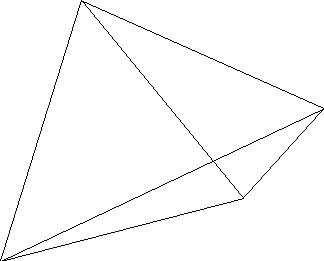Tetrahedra
Prepared by:
Joseph Malkevitch
Department of Mathematics and Computing
York College (CUNY)
Jamaica, New York 11451
email: malkevitch@york.cuny.edu
web page: www.york.cuny.edu/~malk
Idea: Given a supply of congruent triangles with specified properties, what polyhedra can one build with these triangles?
Since the simplest polyhedron is a tetrahedron (a 3-dimensional solid with 4 vertices, 4 faces (all triangles) and 6 edges), this seems a good place to begin.

Can one make a tetrahedron with:
a. Congruent equilateral triangles
b. Congruent isosceles triangles
(If the two side lengths are a and b, can one build a tetrahedron with triangles whose sides are a, a, b? with sides b, b, and a?)
c. Congruent right isosceles triangles
d. Congruent right triangles
e. Congruent acute angle triangles all of whose side lengths are different
f. Congruent obtuse angle triangles all of whose size lengths are different
Followups:
i. Explore further by allowing the triangles to have different sizes rather than being all the same.
ii. To make a triangle from three sticks of length a, b, c we must have that the sum of two of these lengths must be at least as large as the third. Can you find some similar condition on the edge lengths of a tetrahedron that would make it constructible?
iii. A tetrahedron has 6 edges. Can it have all its edges the same length? What about 5 edges of equal length and 1 different? What about other partitions of 6 (e.g. 4 equal length, 2 equal length)?
iv. What is the "next simplest" polyhedron after the tetrahedron? Try repeating the questions here for that solid.
v. Polyhedra can be thought of as being made from either rods or polygons. What are the pros and cons of these two points of view for the questions raised here?
vi. Study the nets that can arise from some of the special types of tetrahedra that one can make. A net of a polyhedron is obtained by cutting along edges of the polyhedron and flattening out the panels to obtain a polygon that folds to the original polyhedron. Some of the ways to cut along the edges may result in "overlaps" of the panels. It turns out that there is a tetrahedron for which one way to cut along the edges does indeed lead to overlapping panels. However, it is a conjecture of Geoffrey Shephard that some way of cutting along the edges of a convex polyhedron will avoid overlaps.
vii. Can one have a tetrahedron with exactly one equilateral triangle? Exactly 2 equilateral triangles? Exactly 3 equilateral triangles? Exactly 4 equilateral triangles?
viii. Can one fold a rectangle (square) into a tetrahedron (by pasting together sections of the boundary)? Can one get a regular tetrahedron by folding a square? Are there any convex quadrilaterals which will fold to a regular tetrahedron? How does the set of convex polyhedra vary with the convex quadrilateral that one might chose to fold?
Note: A rich source of information about folding problems is the book by Erik Demaine and Joseph O'Rourke, Geometric Folding Algorithms.